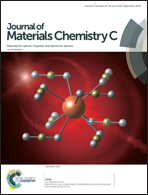Sulfur-bridged tetraphenylethylene AIEgens for deep-blue organic light-emitting diodes†
Abstract
Pure color deep-blue organic light-emitting diodes (OLEDs) with electroluminescence emission peaks in the range of 450–460 nm and high external quantum efficiency are rare. Sulfur-bridged tetraphenylethylene (TPE) was selected as a fluorophore core to develop new materials that exhibit pure color deep-blue emission and aggregation-induced emission (AIE) characteristics. Four compounds introducing carbazole and diphenylamine groups as hole-transporting units were designed and synthesized. The synthesized AIE-active materials are highly thermally stable and exhibit wide band gaps with blue fluorescence emissions positioned at 434–473 nm in the solid state. The use of the diphenylamine substituted sulfur-bridged TPE molecule in a non-doped OLED and in its doped OLED results in similarly good device performances, in which all doped OLED devices show pure color of deep-blue emissions with narrow full width at half maxima (56–65 nm) and electroluminescence peaks at 452–454 nm. Its best external quantum efficiency is 2.75% with the largest and practical luminance of 4277 cd m−2, which is among the best pure color deep-blue OLEDs based on AIE materials.



 Please wait while we load your content...
Please wait while we load your content...